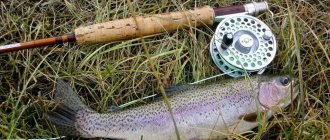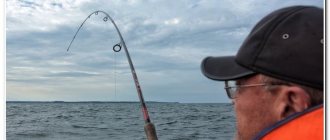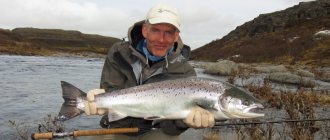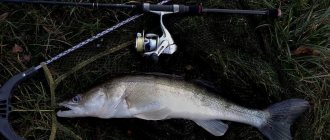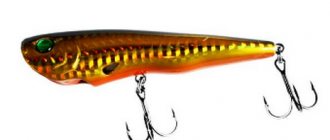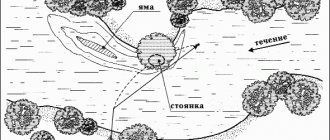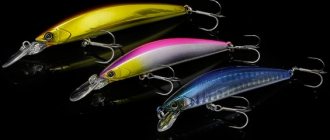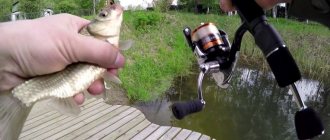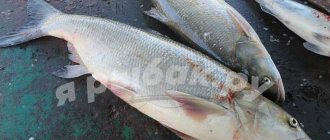Knock-knock - come in...
The method of fishing using a fario telereglable rod (literally translated - “adjustable telescope for trout”) came to us from Europe.
It is very popular in these countries - in those areas where there are mountain trout rivers. So. For example, they catch brook trout in France and came up with a special name for this method: “peche au toc”, which means “knock fishing”. The angler determines the bite, as they say, by touch, constantly holding the fishing line in his hands, slightly pulling it to the side in the area between the reel and the first ring of the rod. So the trout bite is transmitted to the hand in the form of a kind of “knock-knock”. But, perhaps, this fishing method gained the greatest popularity in Italy. Most likely, it was there that it originated, since it is, in fact, a modified Bolognese tackle, taking into account the specific specifics of fishing. I would even say that an adjustable telescope occupies an intermediate position somewhere between float tackle, spinning rod and fly fishing! My acquaintance with this original and catchy method of fishing happened completely by accident. The story is, of course, funny, but I think it’s worth telling.
An invitation came to the World Championships in Italy. I don’t know how it happened, but everyone was completely sure that they were going to fish with a float rod, and in the end they ended up in mountainous Italy on a trout river. The organizers took pity on the Russian would-be athletes, who looked rather ridiculous here with their bleak and match fishing rods, and gave us all the necessary equipment, including adjustable telescopes for trout fishing. That's when I first became acquainted with this gear.
The personal judge assigned to each participant treated me loyally, at first he suggested how to assemble the tackle, and even advised where it was better to cast, how to attach the worm, etc. And after the end of the competition, he noted that I had mastered a new method of fishing quite quickly. After this trip, the idea arose to apply the experience gained at home. In our Krasnodar region, in the mountain rivers there is also trout, and in addition to it there are also chub, barbel, and podust, which can also be caught very successfully with this tackle.
This method is justified even on small flat rivers with a current, where it is difficult to fish in other ways due to trees hanging over the water.
Which rivers are suitable for us? Trout in the Caucasus.
Trout in the Caucasus
However, I will immediately note that in the mountain rivers of the Caucasus, not all trout sites are accessible for spinning fishing. Tackle, bait and spinning have nothing to do with it - the rivers simply have too fast flows and many hard-to-reach places. For example, the upper reaches of the Terek, Inguri, Rioni, Aragvi, our famous rivers that originate in the glaciers of the Main Caucasus Range (in particular, the Central Caucasus), are completely unsuitable for spinning : for many kilometers there is a continuous foamy rapids, and to make a full-fledged wiring a spinning bait is not possible.
It’s exactly the same in the North Caucasus: the rivers running down from the Side and Main ridges of the Central Caucasus are not very suitable for spinning baits, well, unless there are a few sections where the gorges widen and rivers flow on their flat bottom. But even there, due to the high water level and the content of a significant amount of suspended material, the fishing season is very limited: water clearing most often occurs from August - September, when night temperatures become lower and glaciers stop melting intensively.
Better for spinning anglers are the rivers descending from the Skalisty and Lesisty ridges - for example, Khaznidon, Psygansu, Lesken. And the most suitable rivers for spinning trout fishing in Georgia are located in the Samegrelo region. Their sources are not on the Main Caucasus Ridge, but on parallel, lower ridges. Glacial feeding here is not so pronounced, so the river water brightens much earlier after the spring flood. These rivers are so good that they provide excellent fly fishing.
Some deep rivers of the Lesser Caucasus in Imereti, Guria and Adjara, as well as part of the rivers of the volcanic highlands of Southern Georgia, are also suitable for spinning The latter are most suitable for those who like to hunt with a spinning rod , because... Seasonal fluctuations in water here are least pronounced, and a significant part of the diet comes from spring waters.
Trout rivers of the Caucasus
Here I would immediately like to say a few words about the legal aspect of trout fishing. In Europe, brook trout is a very common object of recreational fishing. Our situation is more complicated. I'll try to describe it in a nutshell.
Almost all rivers in the Caucasus, namely their mountainous sections, are trout rivers. But in some of them, local rules for recreational and sport fishing prohibit fishing for this fish. For example, we cannot fish for trout in the Mzymta, Shakh, Psezuapse and several other smaller rivers. And in the Republic of Adygea, trout is completely listed in the Red Book. So before you go to the mountains with a trout fishing rod, it is better to make sure with the local fisheries authorities that your efforts are legal. But so that the reader does not get the wrong impression, I will note that most of the rivers in the Krasnodar Territory are completely open in this sense to fishermen. But there are also mountain rivers of the Stavropol Territory, Karachay-Cherkessia, Abkhazia, Dagestan, Ossetia, not to mention other regions of the country.
For this beautiful motley fish, the limiting conditions are essentially two: water temperature and, therefore, the amount of oxygen dissolved in it. For the most part, the rivers of the Caucasus begin from the tops of mountains and are fed by glaciers. Their peculiarity is that the water level varies greatly throughout the year. So, in spring and summer, during the period of rapid snow melting, the water level rises sharply.
At this time, the powerful flow of water takes on the color of coffee with milk. At the end of summer, autumn and winter, if there is no heavy rain, the water is clear.
The species composition of the ichthyofauna of mountain rivers is not very rich, which is primarily due to their low food supply. Most of the fish population lives in the middle and lower reaches, and in the mountainous part, almost one species dominates - trout, so such sections of rivers can safely be called trout. In these “uncomfortable” conditions, the trout feels excellent, occupying this ecological niche almost alone.
A little lower, where the water warms up more, other species appear: bystryanka, gudgeon, barbel, chub, podust, minnow, loach. Many of these fish can also be successfully caught with a trout rod, but today we will talk specifically about trout.
Habitats

In addition to the already mentioned rapid water currents and numerous whirlpools, there are also a lot of places in the Caucasus that are difficult to reach for fishing. Basically, most foamy waters are not suitable for spinning fishing. Therefore, for fishing it is worth choosing rivers running from ridges (for example, from Lesistoy or Skalistoy), such as: Lesken, Khaznidon, Psygansu and so on. You should look for trout sites. Most often these are holes under waterfalls and rapids, quiet, deep areas of water areas. Trout prefers cool water areas with good aeration and clean water masses. Trout cannot be found in dirty water.
There are certainly much more spotted trout in the mountainous parts of the rivers flowing into the Black Sea than in the lower reaches. Where these rivers flow through the city limits of the resorts, in addition to it, the rivers are inhabited by podust, barbel, chub, roach, sculpin goby, minnow and some other species of fish. High in the mountains, of all this species diversity, only the trout itself, the roach and the sculpin goby remain. You can catch brook trout in the river absolutely anywhere, from the mouth to the smallest stream that flows into the river.
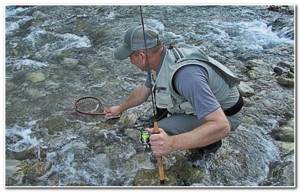
Small but gluttonous...
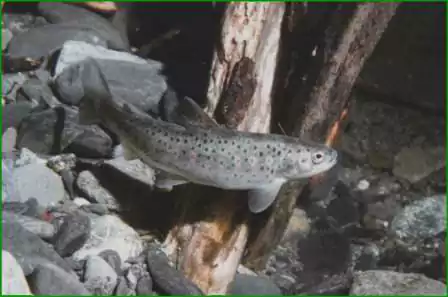
Brook trout, or Salmo trutta morfa fario, can reach a length of 50 cm, but the usual size of the specimens that I have caught in the mountain rivers of the Krasnodar region is 20-30 cm. However, in large closed reservoirs this fish reaches a weight of 3 kilograms , forming a lake form there, but this is a topic for another discussion.
Brook trout is omnivorous: it feeds on insects and their larvae, crustaceans. Adult trout are predators, and they do not disdain their own young. She reaches sexual maturity at the age of 3-4 years, and spawning occurs in autumn-winter.
It is more useful for the fisherman to know how the taste preferences of trout change throughout the year. During spring floods, many different living creatures enter the river, mainly worms and insect larvae, which form the basis of its diet at this time. In summer and early autumn, it feeds mainly on insects, and easily switches from one type to another as the years of some insects end and the years of other insects begin. Closer to autumn, when the caterpillars begin to fall, the trout again changes its taste preferences. In the autumn, closer to winter, it also pursues the juveniles of other fish species that have grown over the summer, if they are present in this section of the river. During spawning, trout can even feast on their own caviar, especially since insects are difficult at this time.
And it also happens that in one year or another, for some reason, there is no mass flight of insects, so she sits in the river hungry and attacks everything that falls into the water. There are also dry years, when there are no floods, and little food is washed into the river, some insects develop poorly, or, say, there are few caterpillars. Then hard times come for the trout. But such years are especially remembered by the fisherman for a good bite.
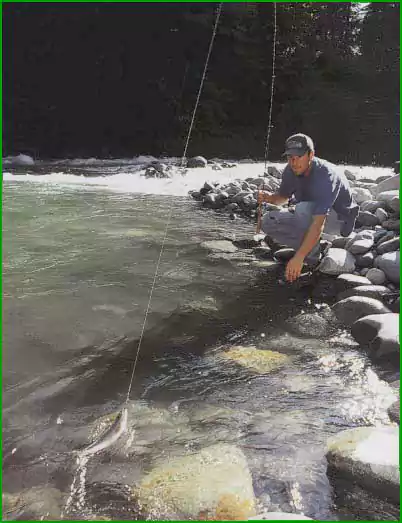
Trout is a predator, and is sometimes caught on a “spinner” no worse than on a worm
Trout fishing with paste equipment
Trout hunting is fun and challenging at the same time. This predatory fish is very attentive; it bites only if the bait is of animal origin.
Donka is one of the best structures for trout fishing. It allows you to fish both on the bottom and while floating. For this type of fish, the second option is suitable, since the predator prefers bait that can move.
First you need to find the trout habitat. She constantly moves in search of food, changing her location.
The best time to catch trout on a donk is the end of autumn, the beginning of winter.
The predator goes out to hunt for food at dawn or dusk. During daylight hours, it hides at the bottom or in snags.
- In winter, the fish becomes very attentive. Be quiet so as not to scare her away. In severe frosts, she becomes lazy. The digestion process worsens, causing the trout to eat less. It becomes more difficult to catch her. At this time, you need bait with a strong smell.
- For fishing, it is recommended to use a paste with a strong smell and glitter.
- In spring the fish are more active. The best time to catch it is late March - early April.
- In summer the bite is worse. The predator prefers cold water, so it goes to the bottom. It is very difficult to catch trout during the daytime. But at night and in the morning the chances are quite high.
- Autumn is a good time for trout fishing. The mating season begins for the fish. At this time, it lives almost throughout the entire reservoir. Suitable weather conditions are heavy rain or light frost from −1 to −3 degrees. At the end of September, the predator begins to lay eggs. To do this, she looks for shallow places. This is where you should start looking for trout at this time of year.
Description of the gear
A special telescopic rod is used for catching brook trout, with butt legs that are fixed at different lengths, which allows you to extend and fold the rod to a suitable length when fishing, i.e. change its working part within very wide limits. A compact telescope is the optimal solution when driving through difficult mountainous terrain.
This design is also convenient for fishing when branches or other obstacles hanging from above interfere. That is why this rod received the name adjustable telescope in the West. Essentially, this is a variation on the theme of the Bolognese tackle. By the way, in the mountain rivers where I have fished, locals often use ordinary telescopic rods for trout fishing, although they are forced to put up with certain inconveniences when fishing.
Branded adjustable telescopes have a length from 4 to 13 m. They are produced mainly by Italians; the well-known companies MILO and TRABUCCO are considered leaders in this field.
A reel is a must-have addition to such a fishing rod. The same Italians recommend reels with a closed spool, which are especially convenient for this method of fishing. The fact is that the fisherman constantly works during the fishing process with a part of the fishing line between the reel spool and the first guide ring. Taking the fishing line to the side, he not only determines the bite from it, but also plays along with the tackle, slowing down and releasing the bait. It is the reel with a closed spool that allows you to throw the line not only straight forward, but also to the side, which makes working with the tackle much easier. A special brake lever located under the fisherman’s finger simplifies the task even more.
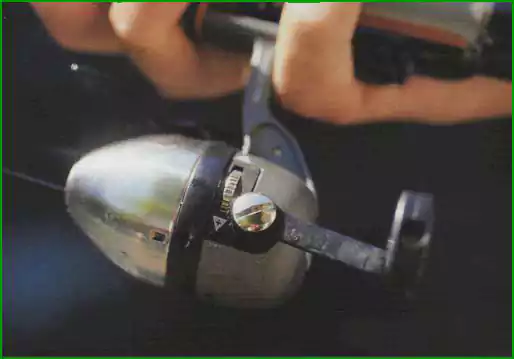
The reel with a closed spool seems to be specially designed for this method of fishing
Previously, reels with a closed spool were quite popular, not only among floaters, but also among spinners. But currently the demand for them has decreased, and many manufacturing companies have discontinued their production. Thank God that in the catalogs of some companies, for example, SHAKESPEARE, these reels are still represented in a wide range of models.
When fishing, the reel clutch should be very soft, because... Trout have far from the strongest lips in the fish tribe. In addition, if the clutch is overtightened, the hooked fish can simply be knocked down by the flow. A softly adjusted clutch is also important when you have to fold the rod after hooking when fishing in an inconvenient place.
The equipment for trout fishing is very original (Fig. 1). The main line on the reel spool should have a diameter of 0.2 to 0.25, the leader, naturally, is slightly thinner than the main line. Such a relatively large diameter of the fishing line is by no means accidental - the fishing line, as mentioned above, must withstand not only the weight of the fish, but also the force of the current. Many companies, including the Italian MILO and TRABUCCO, produce special series of trout lines.
1. Standard equipment for trout fishing
Next comes a 60-centimeter insert with “pellet” weights attached to it. The “pellets” are located evenly on the fishing line every 3-4 cm. This is the most universal option. I’ll talk more about variations on this theme below. On both sides, the insert ends with swivels No. 16-20, and instead of the lower swivel, to which the leash should be attached, a double swivel is often used to further reduce the twisting of the line during fishing. A nozzle in a fast stream often acts like a real propeller, spinning the leash, and a chain of swivels helps solve this problem.
If you are planning to fish on a familiar river, the inserts can be prepared at home and transported to the reservoir on reels. If you plan to fish in an unfamiliar place, it is better to first assess the strength of the current and the specifics of fishing.
The length of the leash is on average 20-30 cm. It, as expected, should be slightly thinner than the insert and the main line. There are special series of trout hooks, but in principle any sharp hook with a long shank, No. 4-10 according to the international classification, will do. The final choice of its size depends on the size of the nozzle and the dimensions of the potential prey.
As I already said, a float is not provided in this tackle; the angler feels the bite directly with his hand. But a kind of beacon is attached to the main line above the insert, which allows you to monitor how the equipment moves in a stormy stream. For these purposes, there are special beacons painted with bright fluorescent paints. But you can successfully use small floats instead or simply put a bright 5-7 cm cambric on the fishing line, securing it with a stick, match, etc. The beacon is not designed to hold the equipment; it is always located just above the surface of the water, but the fisherman will not let the equipment out of sight.
The most delicate moment is the location of the “pellets” on the fishing line. For weaker currents and relatively shallow depths, equipment is used in which the distance between the “pellets” is the same and is approximately 3 cm. But a mountain river is an endless alternation of holes and riffles, rapids and sections of calmer flow, so the equipment has to be constantly adjusted according to during the fishing process. If the depth and strength of the current increase, then the “pellets” must be moved closer to the leash, grouping them at the lower edge of the insert, and when the depth and strength of the current decrease, move them apart again, moving them away from the leash.
In addition to equipment with evenly spaced weights, there is an option where the number of “pellets” increases as it approaches the leash. If you look from top to bottom, the distance between the weights should decrease from 4 (at the beacon) to 0.5 cm (at the leash). The exact number of “pellets” and their size naturally depend on the speed of the current and the depth: the slower the current and the shallower the depth, the lighter the loading, and vice versa, if the current is quite strong and the depths are relatively large, the total weight of the loading should be greater.
In most cases, the equipment should move in the middle and lower layers of water, and the worse the bite and the more passive the fish, the heavier the equipment should be, the more tightly it should be collected around the leash. And if the fish actively rises to the upper layers of water for food, you can use lighter equipment with evenly distributed weights.

A fishing line held in your hand is not only a guarantee of timely hooking, but also the ability to carry out even the most intricate wiring
Where and when to fish
You can try your luck at trout fishing at any time of the year. But spinning fishing will have its own characteristics:
- in autumn the fish prepare for spawning, it is very voracious and aggressive, bites well and relaxes its vigilance;
- winter will require patience and caution from the fisherman: trout become lethargic and can spend a lot of time at the bottom. At the same time, the fish is very careful; it can be scared off by the slightest noise or careless movement;
- in the spring, until the water is heated higher than twenty degrees, the fish are active and feed willingly. It can remain for a long time among coastal vegetation;
- In summer, the fish hide from the heat and usually bite only in the morning and evening. It is better to lie in wait for trout at this time near the exit from the pits.
However, the optimal time for spinning fishing begins in late spring and continues until the first autumn cold weather. At this time, the fish are cautious but predictable. She eats a lot, which means she reacts to bait.
Spinning rods for trout fishing should be selected depending on the planned fishing location. Fishing on an overgrown bank requires a short rod; to lure fish out of holes, you need a spinning rod that allows you to make an accurate cast.
The BlackHoleHi-Light7' series rod is universal. It is suitable for fishing in fast rivers and ponds with still water. Characteristics:
- bait weight – 3-7 g;
- model weight 71-100 g;
- graphite fiber rod;
- touch reel seat;
- super-light rings on single legs.
The Shimano brand of spinning rods is designed specifically for trout fishing. For fishing at short distances, that is, for river fishing, Shimano Yasei Trout River is ideal:
- test 2-14 g;
- length 198 cm;
- 2 sections;
- 7 rings.
Shimano Trout Lake is designed specifically for fishing in ponds and lakes:
- test 7-28g;
- length 2.51 cm;
- 2 sections;
- 9 rings.
The casting weight of the models is suitable for popular trout baits.
Ultralight
Models in this class are distinguished by a variety of characteristics and a wide range of applications. The length of their rod can reach 240 cm, the weight of the bait used for different models ranges from 0.8 g to 12 g.
The super-light spinning rod is great for trout fishing, as it is designed for light bait weight, allows you to clearly respond to bites and carry out timely hooks.
The SportMax50UL spinning rod is ideal for trout fishing in cramped conditions - when fishing in a wild reservoir among bushes and reeds, you have to cast from an awkward position. The length of this spinning rod is 152 cm.
Features of SportMax50UL:
- rod rigidity;
- short handle;
- excellent sensors when wiring;
- light small rings on a titanium frame.
The MYSTIC Irukandji IKJ782L spinning rod is designed for fishing for pond trout or fishing in large rivers with gentle currents. Its length is 233 cm.
Its main differences:
- high rigidity;
- small dough;
- rod sensitivity;
- spaced handle made of EVA;
- reel seat with front nut.
The SportMax60UL spinning rod is universal; it is perfect for spinners, spinners and crankbaits.
SportMax60UL is designed specifically for trout fishing in small rivers. It performs well on long-distance casts of light, about 5 gr., baits. If necessary, the spinning rod can be overloaded to 10-12 g. The model has:
- medium hardness;
- medium tuning;
- high sensitivity during wiring.
Japanese
In Japan, trout fishing in small but fast mountain rivers is very popular. Therefore, most Japanese spinning rods are short. “Japanese” are most often intended for fishing with wobblers.
Souls spinning rods are considered one of the best. The Trout Finalist Explorer has a comfortable handle and is quite powerful. Allows you to hold both small and fairly large fish. Can be used both on the current and among thickets.
The model of the same company, Trout Finalist Avantgarde, is one of the best for casting, ideal for fishing in rivers with strong currents.
M-Aire Trucha Boron is a manufacturer of excellent quality spinning rods. Model 53L is more suitable for fishing with cranks in currents, and model 52M is more rigid and is used for fishing with a wobbler in strong currents.
Manufacturer Smith produces powerful spinning rods, the Troutin'spin LagLess Boron model is for heavy stream baits. Suitable for fishing in rivers and streams.
When fishing for trout, every detail of the equipment matters.
When fishing for trout, great attention should be paid to the selection of fishing line for trout fishing with a spinning rod. This species is a strong and cautious fish. To successfully fish with it, the fishing line must:
- have easy stretchability;
- be moderately elastic, but not very springy;
- remain invisible to the fish.
For trout fishing, a high-quality monofilament with a thickness of 0.15-0.25 mm is suitable. with a breaking load of 3.5 kg – it has all the listed qualities. Experienced fishermen note that the brand of fishing line does not matter much.
All monofilaments, both domestic and imported, have approximately the same characteristics.
Exceptions when a fisherman may need a braided fishing line is when fishing at a very long distance - more than 20 meters. In this case, the thread allows you to make a more accurate and longer cast and provides better sensitivity. With braids, everything is not as good as with monofilaments; their quality can vary greatly. Least visible in water and most resistant to tearing models:
- YGK ULTRA SURF WX4 0.4,
- Sunline SUPER CAST PE 0.6.,
- PRO-JIG 0.09 mm.
Coil
Leash
Currently, fishing with a retractable leash is very popular, but the application of innovation to trout fishing is a controversial issue. It is advisable to use a leash on a rod longer than 2.4 m, and in trout fishing, short light or ultra-light spinning rods are more often used.
Trout lives in fresh water and loves clean and very cold rivers. Most often it lives in mountain lakes. There are two types of predator: lake and stream. The fish is highly attentive and cautious, which is why it is quite difficult to catch. There are paid reservoirs for catching trout. At the same time, there are places where it is bred.
At the end of winter, when the ice melts, trout become active.
This fish loves rivers with large currents. This is because in the daytime, when trout are not hunting, they go to the bottom, stand against the current, and begin to catch fry swimming with the flow. She prefers rocky bottoms.
One of the important parts of the design is the leash. Its optimal length is about a meter. The diameter of the fishing line is 0.15 millimeters.
Trout tackle must be floating. If the weight of the bait is too heavy, use foam balls.
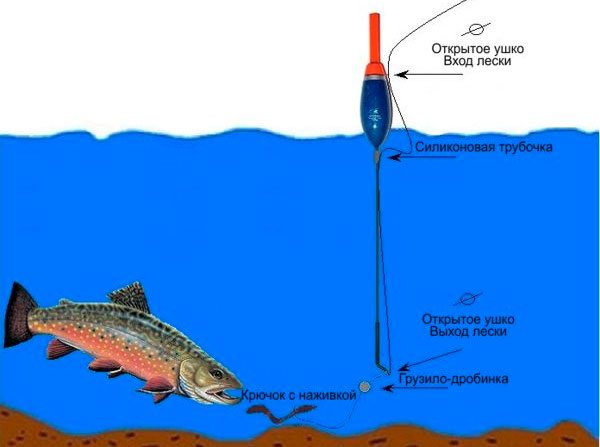
Take care of spare balls, as fish often knock them off when biting. Instead of foam plastic, floating plasticine is also used.
It hardens well in cold water, so it becomes impossible to knock it off. The design should be as durable as possible, since sharp hooks are possible when fishing for trout.
Any fishing line is suitable except braided one, since braided line does not stretch well and is not suitable for sharp hooking. Take a sinker weighing 40-50 grams. The optimal shape is a circle or oval.
Any hooks will do. The main thing is that they are quite sharp.
Fishermen are constantly coming up with new designs for trout fishing. You can buy a ready-made design at a fishing store and remake it at your discretion.
A ball with a diameter of 10 millimeters is made from the paste. The ball is placed on the hook. Hide the point of the hook inside the paste so that the fish does not notice it. Fix the paste on the hook with your fingers so that it does not slip off during the current. You can throw bait into the water. Use a mold to shape the paste as desired. Predators are caught on them more often. These molds are sold in fishing stores.
How to use trout paste
The use of the paste depends on the time of year. It is difficult to use in winter. This takes practice. In winter, trout are picky about their food choices. She becomes cautious and reacts to any noise. Therefore, pay attention to the following:
- In winter, you should rely on baits that have a very strong smell. But the smell should not be strong, so as not to scare away the fish. You should add glitter to the bait, this will attract additional attention.
- Finding trout habitat becomes a big difficulty. The fish does not stand in one place, but constantly moves in search of food. However, it can live only at the bottom or only on the surface of the water.
- If you catch a fish in one hole, move on to the next, as there can only be one fish in one hole.
- If your area has warm winters, use the paste as you would at other times of the year.
The paste should not be frozen so that it does not lose its properties.
The secret of catchy pasta
Trout paste consists of proteins with added flavors. The following flavors work well:
- Garlic.
- Cheese.
- Fish.
- Caviar.
The primaka is cooked depending on whether you want it to touch the bottom or not. Experienced anglers choose the second option, since trout prefer the middle and upper layers of water.
If you are fishing in holes, you will need sinking paste. But there is no need to prepare both options.
Prepare a sinking paste and attach a piece of foam to the bait. This way she won't drown.
If you need the paste to sink, increase the amount of weight.
Shine is added to the store-bought paste, which provokes the fish even more. Of the colors, trout respond better to yellow and orange.
Putting pasta on a hook
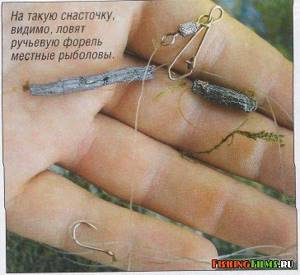
It is considered difficult to place pasta on a hook. But that's not true. You will need:
- Take a small piece of food.
- Make a ball the size of a corn kernel.
- Place the paste on the hook so that the point and shank are hidden.
- Seal the paste with your fingers so that it does not wash off in the water.
Spinning fishing for trout in its natural habitat is a process more similar to hunting than to fishing. It comes down to the special requirements for equipment, gear, tackle, health and general physical fitness of an angler who wants to catch the most beautiful and noble, in my opinion, fish on the planet.
And given the number of animal tracks on the trails along the reservoir, having some hunting skills will definitely not hurt here; in any case, knowledge of the habits of some wild animals, for example, bears, will come in handy.
The main habitats for trout are streams and rivers with cold water and fast currents. Many of them are located in mountainous areas, for example, in the Caucasus.
A fast flow in a stream or river ensures sufficient saturation of water with oxygen and maintains its temperature within 10-13 °C. Typical trout waters are often quite shallow. Most of them can be easily forded almost anywhere. They usually occur in wooded areas.
People watching spinning rods often think that fishing with this equipment is quite easy. You just need to cast the fishing rod as far as possible and rotate the reel.
However, do not forget that there are different wiring, which will take a lot of time to master.
Among them are the following:
- Uniform winding of the fishing line. This method is one of the simplest and most common. First, the line is cast, and after the spoon has dropped to the bottom, reeling occurs. When fishing with this method, you can use any bait, increasing or decreasing the rotation speed of the reel.
- Twitching. When the bait reaches the desired depth, a sharp jerk is made with your fingertips.
- Jig wiring. At the same time, the nozzle moves in steps, sometimes rising sharply, sometimes falling to the bottom. As soon as the bait reaches the desired depth, the fisherman should begin rotating the reel. The duration of the pause depends on the type of fish being hunted.
It happens that an angler who has the necessary skills and experience fails. He despairs, not understanding that the reason for the failure is the wrong selection of spinning rod.
When fishing for trout, you need to pay attention to such parameters as: the length and action of the rod, and you also need to select equipment and bait.
Length selection
Many fishermen immediately purchase a spinning rod of maximum length, based on the opinion that thanks to this device it will be easier to retrieve, overcome bushes and grassy thickets. Of course, a three-meter spinning rod can be cast further than exactly the same, but smaller length. However, all these advantages also have their disadvantages.
With a long spinning rod, moving through overgrown thickets and coastal areas is extremely inconvenient. In addition, the angler may be injured as a result of a fall caused by loss of balance or snagging of the gear.
Making an accurate throw with a long rod can sometimes also be very difficult. Sometimes it happens that you have to throw a spinning rod from an awkward position, and even through a small window. At this moment, the fisherman begins to feel inconvenience due to the large length.
Based on the above, the length of the spinning rod must be chosen based on the terrain where the hunt will take place and the preferences of the fisherman himself.
Scale selection
Most anglers do not recommend using fast action spinning rods. Because even the smallest fish on the hook will make a lot of kicks. In this case, it will bend under such a strong load. And only thanks to a flexible form can this effect be reduced, and then tire the fish.
Selection of equipment
To catch trout, a thin fluorocarbon line with a diameter of 0.02 millimeters is installed on a spinning rod. Sometimes an additional long leash (75 centimeters) is also used. And to prevent the line from twisting, a special swivel is attached.
Also, don't underestimate the importance of the reel. For trout fishing, it is recommended to choose a spinning rod with a high gear ratio (at least 5:1).
They choose it precisely because during the wiring process it is necessary to rotate the handle at high speed. Therefore, a device with a reliable and instant reverse stop is attached to the tackle. This is also required so that during rotation the fishing line immediately gathers and the darling is clearly fixed.
How to catch more fish? I have been actively fishing for quite some time and have found many ways to improve the bite. And here are the most effective ones: Bite activator.
Attracts fish in cold and warm water with the help of pheromones included in the composition and stimulates its appetite. It’s a pity that Rosprirodnadzor wants to impose a ban on its sale.
More sensitive gear. Reviews and instructions for other types of gear can be found on the pages of my website.
Lures using pheromones. You can get the rest of the secrets of successful fishing for free by reading our other articles on the site.
Bait selection
Usually, to catch trout, they take a small weight spoon or wobblers less than 10 centimeters long. In sunny weather, give preference to brightly colored baits.
Please note that if the fish is caught at shallow depths, then it is advisable to take a light bait, and in case of strong currents, preference should be given to more massive options.
The best time to hunt trout is early spring. At this time, you can catch many large specimens of this fish.
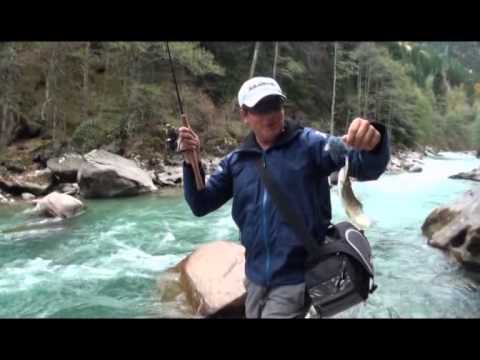
Also in spring, trout are not particularly wary; they can often be found in easily accessible places. Mostly this fish lives in small and shallow reservoirs.
And closer to the middle of the month, with the onset of warmth and the arrival of insects, you can safely set out to catch trophy specimens in absolutely any reservoir and regardless of their depth.
Experienced fishermen advise following the following rules, with the help of which you will always be guaranteed a catch:
- the bait must be kept in the current, without reeling in the fishing line, while slightly lowering it down; in this case you will have many chances of catching large fish;
- You should choose quiet places for fishing behind the rocks, because... trout are known to periodically take a break from the turbulent current.
Not everyone can catch trout in muddy water. In this case, it is better to take a fluorescent spoon and cast it as accurately as possible.
Often fish can also be seen in holes that are formed due to fallen trees. In this situation, you should take a wobbler. And when fishing for trout from the shore, you need to move exclusively upstream.
Once the fish has taken the hook, many inexperienced anglers are faced with another problem: how to pull the fish out. During this time, she will struggle to free herself, so you will need to be resilient and patient to complete the process successfully.
Not everyone can catch a fish like trout. She behaves extremely carefully, and after getting hooked she begins to move very actively, fighting for her freedom to the last.
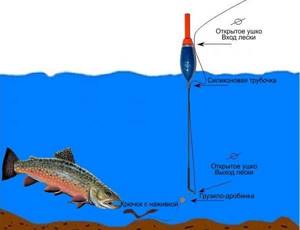
To successfully catch it you need to have certain experience and skills. In this case, spinning is the priority tackle for trout fishing. Since it is used for hunting on lakes or rivers of natural origin, as well as on artificial reservoirs.
Good evening! Here's the next part about catching rainbow trout in open water. Today’s article will describe how to catch rainbow trout using a spinning rod.
Rainbow trout on a spinning rod
As is known, rainbow trout released into commercial reservoirs is a domesticated form of mykiss, wild populations of which live in our country in Kamchatka and the Shantar Islands. Almost all baits are suitable for pond fish as for those living in the wild in fast rivers - small and medium-sized “shakers”, wobblers, “spinners” up to N 3-4.
However, it must be taken into account that if in a strong current the fish is not particularly picky and very active, then in still water it can examine the bait from different angles, and it is not a fact that it is going to swallow it. This usually manifests itself in the fact that the trout ignores large baits.
But in the ponds you can successfully fish with a micro-jig using ordinary stepped wiring, which is rarely possible in Kamchatka. The domestic “rainbow” has spent most of its life in cages and is accustomed to waiting for offerings from above, and therefore a stepped retrieve with a vertical fall of the bait can be attractive to it.
The abundance of suitable baits does not mean that trout will grab every one of them. At the beginning and at the very end of the season, when the water is icy, the fish are not particularly active. To catch it, you need to correctly select both the wiring and the bait.
Equipping a spinning rod for trout fishing should be taken very seriously. The slightest mistake can ruin your entire fishing trip.
The spinning rod should have a medium or even slow action. This will help keep the trout from frantically trying to free themselves.
The length of the rod is selected individually for ease of use. It would be good if the reel seat was screw-type. It's more reliable. The fishing line is monotype 0.2 mm – 0.4 mm, depending on the conditions of the reservoir. A thinner line is suitable for the river.
You can fish for trout all year round, except during the trout spawning season. Fishing for trout in summer is most effective in the morning and evening hours, as well as at night, since trout does not tolerate warm water well and as the water warms up, its activity decreases.
Therefore, you are unlikely to be able to catch trout during the day in the summer. The best time to catch trout in the spring is the afternoon, and in the fall it bites equally all day and night.
Trout fishing will only be effective if the water is clear enough. Trout loves crystal clear water and if it becomes suddenly cloudy, the activity of the fish decreases.
The trout bite reaches its maximum during the mayfly season, which is approximately May-June, depending on the region. In the summer, the trout slows down a little and loses activity due to the heat, but still continues to bite, although less often and more sluggishly. With the arrival of autumn, trout get a second wind and its fishing is picking up speed again.
Nozzles
Worms are the most popular and easily obtained bait. You can collect them under stones and leaves along streams, preferably directly in the place where you are going to fish. According to my observations, a dung red worm, which you can bring with you on a fishing trip or dig up in a compost heap, will bite a little worse than a nondescript whitish worm collected on the shore. Place the worm on the hook with a stocking, sliding it partially onto the line of the leash and bringing the sting out (Fig. 2).
2. Method of attaching a worm
Maggots and beetle larvae are suitable as bait. Fishing for caddis flies is very successful, the houses of which can be collected in the streams flowing into the river. And although this is a very gentle, delicate bait, it literally helps out when the bite is bad.
Often baits are combined, maggots are added to the worm, etc. The larvae of May beetles and other beetles, developing under the bark of rotten trees, are a favorite delicacy of large trout. The baits are stored in a special box with compartments, usually attached to the angler’s belt.
Seasonal activity
At the beginning of the year, in January, while in some rivers the fish have not yet fully spawned, the bite is much better than in February and March. After the complete end of spawning, the trout are apparently too weak and cannot stand even in a weak current. At this time, the fish are located in the calmest places, almost completely without any current. The fisherman can move along the river, either downstream or upstream, and pass by rapids without wasting time. The focus should be on the quietest and deepest places. Especially a lot of fish accumulate in deep holes under waterfalls. Of the baits, wobblers and spinners performed best. Retrieving baits of any type should be as slow as possible.
Spring trout fishing in the Caucasus is very limited. Before the snow starts to melt, you can go fishing a couple of times, but you can’t count on a good bite. As the snow begins to melt, the rivers swell greatly and carry a lot of mud. At this time, due to poor visibility of the bait and very stormy water, spinning fishing is completely impossible. On many rivers this situation lasts until mid-July, or even longer, but in some years it happens differently.
As soon as the melt waters disappear, the river will return to its channel and the water will become lighter—the summer trout fishing season will begin. It is distributed among its favorite sites and begins to feed intensively, reacting well to artificial baits. The gradual decrease in river levels coincides with an increase in the feeding activity of fish. There is another point of view on the prey of this period: it’s just that when there is low water on the hard-to-reach rivers of the Caucasus, it is much easier to get close to the fish and catch it using a spinning rod . The intensity of the bite reaches its highest peak in September, before spawning. But trout fishing has been officially prohibited since September.
A completely different picture emerges in late autumn and winter: trout stop actively feeding in preparation for spawning. It takes artificial baits very strangely: sometimes it attacks the spoon immediately after casting, sometimes after the fifth or sixth retrieve. Sometimes it grabs you in the throat, and sometimes it barely clings to the tee and immediately comes off. In general, when spawning, the fish is lethargic, sick, and behaves very passively, at this time it is better not to disturb it.
I remember one strange incident. It was the end of November. When moving a size 2 golden spinner in an arc diagonally from top to bottom, the trout backed away in front of the approaching spoon, i.e. she simply floated downstream, giving way to the lure. It turned out that it was not the fish that was chasing the bait, but the bait that attacked the fish.
For me personally, fishing at this time of year is very interesting for another reason that the rivers are less visited by anglers and the fish feel calmer. It lives in deep holes and in the calmest places, often reaching the surface of the water. It is during this period that you need to throw the bait at the same point several times.
Fishing technique and equipment
Often, in order to reach the trout section of a mountain river, you have to climb several kilometers of mountains. This activity is very tiring, and the fisherman should not take anything extra with him that could turn out to be a useless load. All you need for this fishing is a rod and a special bag in which you can store equipment and keep the caught fish. A basket bag made of willow twigs allows you to place it directly in the water, and the caught fish will remain alive for a long time.
Trout does not have as strong a smell as other fish, and the bag can be kept clean without any problems. In a special compartment, the equipment on the reels, a set of “pellets”, hooks, swivels, fishing line and extractor are stored here. There are times when a greedy fish swallows the bait very deeply.
An adjustable telescope of decent length allows you to do without waders and heavy wading boots. It is better to dress so that you can climb mountains comfortably. By the way, when moving along steep slopes, you need to be as careful as possible. The hand closest to the slope should be free in case of a fall. If your rod ends up in it at that moment, it will be in trouble.
When approaching a new place, try not to make noise. Trout, like other fish, stands with its head upstream, so by moving towards the source, you can get closer to it without being noticed.
High-quality polarized glasses will serve you well when fishing, as they allow you to see underwater not only standing fish, but also moving equipment.
Having baited the hook and cast the tackle, the angler constantly monitors the movement of the bait using a beacon. A reel with a closed spool allows for various wiring options: holding, playing along, etc. Even with the help of a short rod, “walking” the equipment with the flow, you can fish large sections of the river without leaving one place.
Now let's talk about which parts of the river should be fished with particular passion.
Gear selection
When fishing for trout, it is advisable to have all types of bait in stock:
- spinners,
- vibrators,
- wobblers.
It happens that a fish does not bite one type of bait, but willingly goes for another. In the cold season, trout usually respond better to a wobbler, and in the summer - to a spoon.
However, the predator does not like competition, and a wobbler painted to match the color of the trout itself can bring success to a fisherman at any time of the year.
You should not use homemade gear when catching this fish - cautious trout will not touch dubious prey. She may get scared and the fishing will be ruined.
Among wobblers, the following are especially popular:
- Nils Master Japittaja - moves in the water thanks to flickering movements, suitable for fishing in streams and running water;
- Jackal Chubby 38F - has good gameplay and excellent flight characteristics;
- Halco Rellik Doc - the higher the speed of movement of the wobbler, the narrower the amplitude of its vibrations. Used in streams and standing water.
Trout is a predator. The bait must be of animal origin. Good fit:
- Fish fry.
- Larvae.
- Worms and maggots.
- Insects.
- Pieces of the trout itself.
- Fresh meat or fish.
- Front sights.
- Wobblers.
- Spoon.
The color and aroma of the bait are important.
The bait must constantly move.
The result of trout fishing depends on the proper selection of gear. There are many specialized rods, thin lines and matching reels on the market today, so there is plenty to choose from. Moreover, quite budget products have already appeared that are affordable to most fishermen.
Trout fishing requires mobility and compactness
Of course, rivers have very cold water at any time of the year, so the use of waders is simply necessary. It is always necessary to choose thermal underwear for the comfort of fishing and movement very correctly. The staff won't hurt you at all when moving. Personally, I have been successfully using SIMMS wader equipment for many years, and it has never let me down. One of the main conditions for your fishing should be your mobility and your compactness. Nothing superfluous and at the same time everything you need should always be at your fingertips.
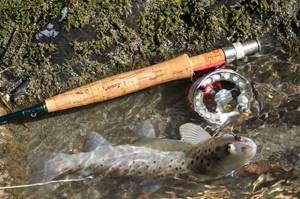
Collective intelligence. Trout in the Caucasus.
On a small river, it is best to hunt for cautious trout alone. to fish after another spinning angler , since there is a limited number of trout spots here, and the area from which the trout was caught is empty for some time. But in the case when an angler in front of you fishes with a wire, the chances of some catch still remain - the float of the wire tackle bothers the fish less than a spoon or wobbler.
Now, if the river is wide, and the water is slightly turbulent, emerald or turquoise in color, you can go after trout in two or even three, but on the condition that you move forward one by one. You should again approach the fishing spot one at a time. In a group of people, it’s better to go upstream, track and sneak up, because... trout in the river stands with its head against the flow. And in extreme fishing conditions, a traveling companion is simply necessary.
If time and conditions permit, you can try fishing for trout in a very exciting way: in the morning, hunt upstream with a spoon, and on the way back in the evening, use a wobbler. There seems to be no rest for the fish, but the results on the same section of the river are very interesting.
On crystal clear rivers, moving downstream requires careful camouflage, and catches can be more modest. It’s better to walk here, of course, alone, and place either a spinner or a wobbler in a good place, or maybe something else - based on specific conditions. Oscillating spoons, spoons with a weight-head, spinner baits, and a variety of “rubber” are also suitable.
If fishermen who know each other well and respect each other are fishing, then it is advisable to move along the river together, one after the other. At the fishing spot, first one acts, and then the other - strictly in turn: while the first one throws, the second one waits on the side - and so on “in a circle”. On our rivers, conditions often do not allow fishing on different banks. If you get a bite, then you must yield the next cast to your friend. After one of the partners catches a fish, the priority right to a good place and the first cast must be given to the other. This makes it easier and faster to select catchable baits, test new ones, and discuss biting problems.
On my favorite river we do this: Aram goes ahead with a fishing rod, I follow him with a spinning rod . In the fall, the catch ranges from 3:1 to 2:1 in favor of a fishing rod with natural bait. But in the summer, it happened that Aram spoiled my fishing: when fishing with a caddis fly, the trout was capricious, as sometimes with a spinner - it fluttered the bait, came out and didn’t take it, but with a spinner it went perfectly, but since he walked in front, I could no longer catch the disturbed fish . But, as I already said, if you do the opposite, i.e. fishing with a fishing rod behind a spinning rod - then the chances of success will be very scanty. As confirmation, I will cite the practice of the same Aram Badalyan: when he sees unfamiliar competing fishermen, he immediately removes the float from his tackle and puts on a spoon. Following him, the “strangers” are left without a catch.
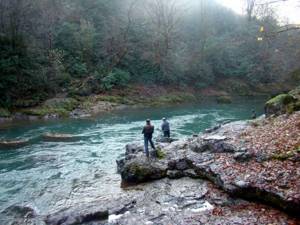
Spinning rod for catching brook trout
When fishing for trout with a spinning rod, fishing a stream or river, casting bait, you must have good spinning fishing technique and be able to make accurate casts. In many places you have to cast the lure close to snags or branches, and here you need pinpoint precision in throwing the bait into the water, a few centimeters away from bushes or stones. You also often have to cast from under overhanging branches and from other inconvenient positions. The slightest inaccuracy usually leads to a hook that will be difficult to unhook without spooking the trout in the river.
For accurate casting, you need not only the ability to throw the lure to the desired point, but also a well-selected spinning rod in length, action and test, equipped with a high-quality reel with fishing line. To catch river trout with a spoon or wobbler, it is better to take a plug-in light or ultralight spinning rod with a Medium-Fast action or a Fast action. And it is better to take such a spinning rod with a length of 180-220 cm, with a test in the range of 0.5-8 grams, since on streams and rivers, trout baits are mainly used small and light, weighing 0.5-10 grams.
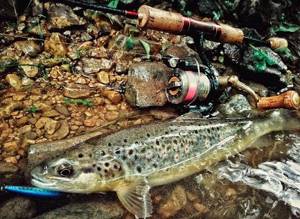
Of course, trout fishing professionals at competitions may have 4-6 spinning rods with different tests and structures. But when actively fishing for trout with a spinning rod on a river where there are many obstacles, bushes, trees and stones, it is better to have one more or less universal spinning rod and perhaps another spare one.
It may seem that a spinning rod with such a small dough looks thin, fragile and can easily break. But if handled correctly, it is impossible to break the spinning rod while fishing for fish; if you avoid sharp angles between the rod handle and the tensioned fishing line, then nothing bad will happen, again, if the fishing line is installed with a load limit for the given spinning rod.
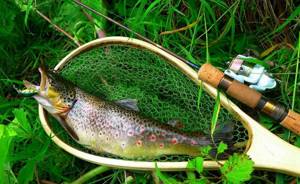
On high-quality spinning rods, the rod blank indicates the maximum breaking load of the fishing line in libres (lb), the same thick fishing line that can be used on this spinning rod without damaging the rod. To determine the diameter of the fishing line, there are comparative tables of the correspondence of the load in units (lb) to the possible diameter of the fishing line in millimeters.
Lures, spoons and wobblers for trout
In the summer, for catching trout with a spinning rod in a stream or river, some of the best baits are spinners or spinners, of which there are a wide variety of shapes, sizes and colors on sale from different manufacturers. The main criterion when choosing a spinner spoon for trout should be fishing conditions, depth, current speed and others. The spoon must be selected in such a way that when casting upstream, stable rotation of the blade is ensured, even at the slowest retrieve speed.

Turntables are classified by numbers depending on their weight and size. The first and second numbers can be considered the universal size of a trout spinner. The colors of trout spinners can work in completely different colors, with copper, silver, gold and even painted petals in a variety of colors. It is always better to experiment and try different sizes of spinners of different shapes and colors for trout.
Trout also bite well on oscillating spinners of bright acidic, as well as the most common silver and copper colors, small in size, 2-7 cm long and weighing 0.5-8 grams. Fishermen sometimes call such spoons as spoons or micro-oscillators. There are many trout spinners on sale from many famous manufacturers, as well as various Chinese spinners, and the choice can sometimes be very difficult. And again, you need to take and try different spoons for trout; sometimes some cheap spoon can turn out to be more catchy than the most expensive spoon from a cool manufacturer.

Nowadays, many wobblers are produced that can be used when fishing for trout using a spinning rod. Many fishermen catch trout with cranks, but standard-shaped wobblers should not be neglected. The sizes of trout cranks are usually 2-4 cm long, and the sizes of wobblers of standard shapes are slightly larger, 4-8 cm long, and weighing 2-7 grams; the colors can be different, both bright and natural. Wobblers for trout with the coloring of a minnow, fry of trout or salmon, are considered catchy, since adult trout often feed on the fry of their own relatives and are very fond of minnows.
It is better to use floating wobblers for trout with a small depth of up to a few centimeters. Having cast such wobblers with a spinning rod, you can float them down the river to inaccessible places, under branches of bushes or trees hanging on the water, where it is impossible to throw a regular spoon, spinner or spoon. You can also use a wobbler where there is a lot of algae and stones in the water, and at the top the water is open and there are no obstacles for bait.
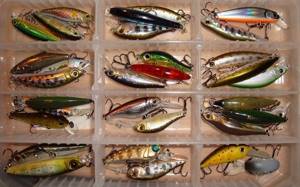
Fishing for trout with jig bait is also practiced by river fishing enthusiasts. But such fishing on the river is quite difficult and is associated with frequent hooks and losses of jig baits among stones and underwater algae. Jig is a bottom bait, and therefore it is better to choose deeper places for catching trout with jig, with a slight current and without obstacles at the bottom. Probably, in the cold season on rivers, jigs are more catchy than in summer, so in winter trout stay in the deep sections of the river. And in spring and summer, trout actively hunt at the surface of the water, and surface baits work more.
Spinning rod equipment for trout
A spinning reel for trout fishing is preferable to a spinning reel with a size of 1000-2500, but we must remember that there is no uniform system of reel sizes, and each manufacturer labels its reels according to its own standards. There is no need to save money on a trout reel and it is better to take a spinning reel of an average price level with real 4-6 bearings, and not with 10-12 bearings, as some manufacturers indicate on the packaging, and sell reels at low prices that fall apart after one or two fishing trips .
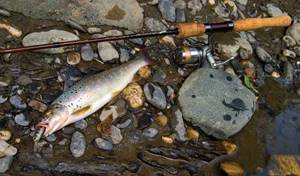
To catch river trout, a spinning rod can be equipped with a braided cord or fishing line with a diameter of 0.14-0.20 mm. Do not forget that the braided line is visible to the fish in the water. But at the same time, the cord is considered more sensitive, the play and vibrations of the bait are transmitted more sensitively through it, and the bite itself is more clearly transmitted through the spinning rod to the fisherman’s hand. Some fishermen more often use a cord, and a leash made of fluorocarbon fishing line 0.5-1.0 meters long with a swivel and a clasp at the end is tied to it. There is no clear opinion as to which is better, cord or fishing line, it is better to try different options and choose the most suitable one for yourself.
